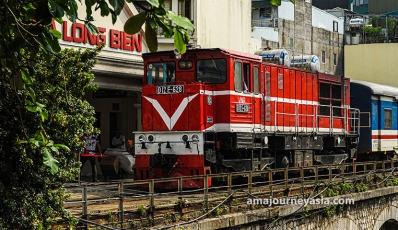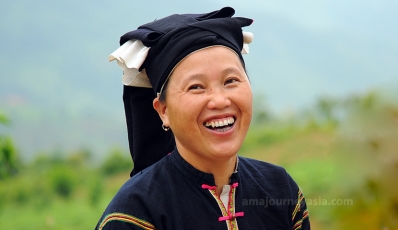The Reunification Palace, also referred to as the Independence Palace, stands as a revered historical monument that bears witness to the remarkable transformations in the history of Ho Chi Minh City (formerly known as Saigon) while embodying the profound essence of Eastern culture.
Amidst the valorous conflicts that unfolded, this magnificent architectural masterpiece stood witness to the myriad triumphs and tribulations of the Vietnam War, etching its indelible mark upon the annals of time.
Table of contents
History of Reunification Palace
Architecture of Reunification Palace
Things to see at Reunification Palace
*****
Location and notices when visiting Reunification Palace
Location: At 135 Nam Ky Khoi Nghia street, Ben Nghe Ward, District 1, Ho Chi Minh city
Opening hours: 8.00am to 4.30pm
Entrance fee: 40 000 VND/adult or 10 000 VND/kid
Please note that there are some sections and exhibitions with different type of entrance fees in the Reunification Palace
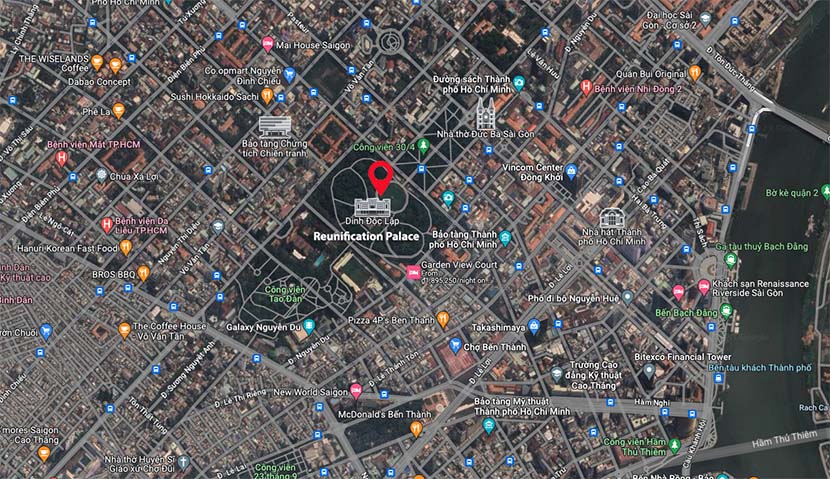
The excellent location of Reunification Palace
Independence Palace holds immense historical significance, making it imperative for visitors to strictly adhere to the rules and regulations set forth by the monument. It is essential to respect and preserve this cherished site. Visitors must be mindful of their actions and understand that they will be held accountable for any damage caused to the palace.
History of Reunification Palace
Back to 1858, when French colonizers launched their assault on Da Nang, marking the commencement of their aggressive war against Vietnam. By 1867, the French had gained control over six provinces, namely Bien Hoa, Gia Dinh, Dinh Tuong, Vinh Long, An Giang, and Ha Tien.
Subsequently, in 1868, the French government undertook the design and construction of an opulent mansion intended to serve as the residence for the Governor of Cochinchine, positioned at the heart of Ho Chi Minh City. Upon its completion, this majestic structure came to be known as Norodom Palace. The construction took 3 years to complete.
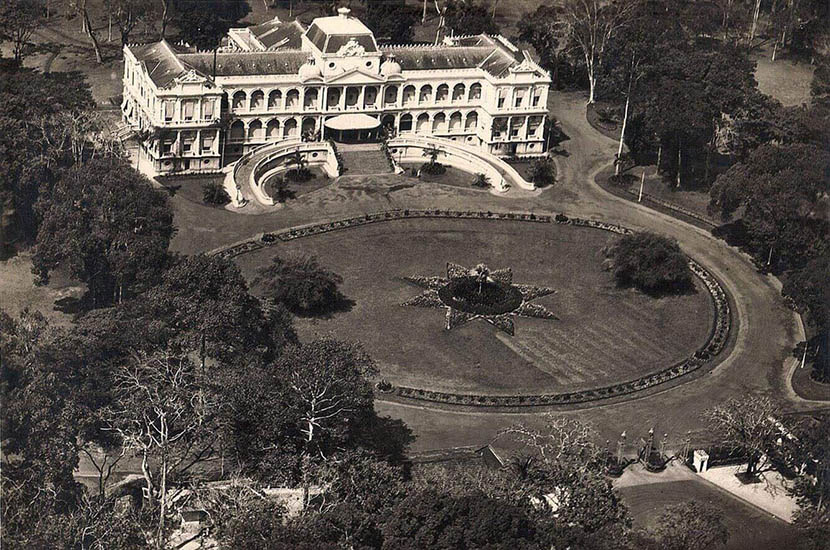
The beauty of Norodom Palace
Between the years 1871 and 1887, the palace served as the official residence of the French Governor of Cochinchine, hence earning the name the Governor's Palace. Subsequently, from 1887 to 1945, it became the abode and administrative headquarters for all the Governors-General of French Indochina, overseeing the region during the period of Indochina's invasion.
On the 9th of March, 1945, the Japanese forces orchestrated a successful coup, overthrowing the French and establishing exclusive control over Indochina. Consequently, Norodom Palace was transformed into the headquarters for the Japanese forces in Vietnam. However, following Japan's defeat in World War II in September 1945, the French regained their presence and authority in Southern Vietnam. Once again, Norodom Palace was designated as the headquarters for the French regime in Vietnam.
In May 1954, following their defeat at the Battle of Dien Bien Phu, the French were compelled to sign the Geneva Agreement, resulting in the withdrawal of their troops from Vietnam. This pivotal event marked the entry of the United States into the conflict, as they sought to establish a presence in the South. Consequently, Vietnam underwent a temporary division into two distinct regions: the North, under the governance of the Democratic Republic of Vietnam, and the South, led by the newly declared Republic of Vietnam under the leadership of Ngo Dinh Diem, with financial backing from the United States. As part of this transformation, the Norodom Palace underwent a renaming and became known as the Independence Palace, serving as the official office and residence of Ngo Dinh Diem and his family.
The audacious bombing that took place in February 1962 caused irreparable damage to the palace, prompting Ngo Dinh Diem president to issue orders for its reconstruction. The construction commenced in 1962, following the architectural design by Vietnamese architect Ngo Viet Thu. Unfortunately, Ngo Dinh Diem never had the opportunity to witness the completion of the new palace as he and his brother were assassinated in 1963. The construction continued, and the new Independence Palace was eventually finished in 1966. From 1967 to 1975, it served as the residence and workplace of Nguyen Van Thieu president.
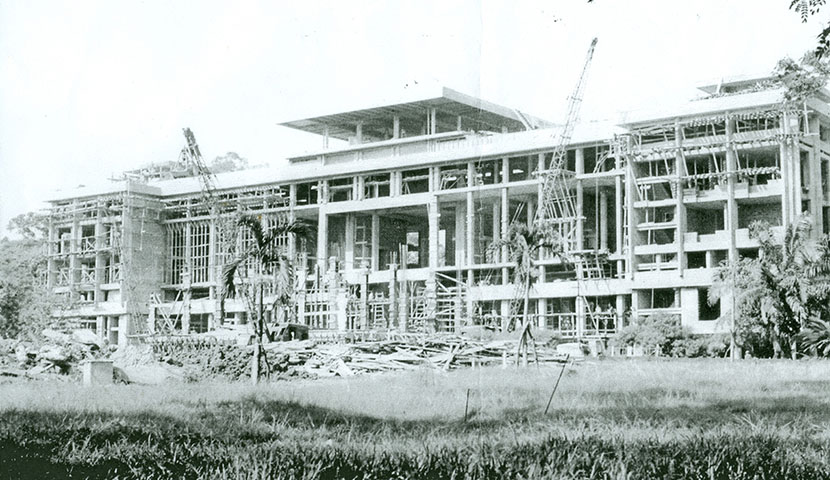
The Independence Palace was being rebuilt after being destroyed
On the 30th of April, 1975, the walls of the Independence Palace were breached by two tanks of the North Vietnamese Army, symbolizing the downfall of the Republic of Vietnam. This momentous event marked the end of the Vietnam War and the reunification of the entire country.
Architecture of Reunification Palace
Spanning an expansive area of 12 hectares, the magnificent building encompasses a grand mansion boasting a remarkable width of 80 meters. There is a vast living room capable of accommodating up to 800 individuals. Moreover, the surrounding campus is adorned with lush greenery, comprising numerous trees and sprawling lawns.
Adorning the front yard of the Palace is a captivating oval lawn, boasting a diameter of 102 meters. Upon crossing the threshold of the gate, visitors are greeted by the sight of vibrant green grass, instilling a sense of tranquility and revitalization.
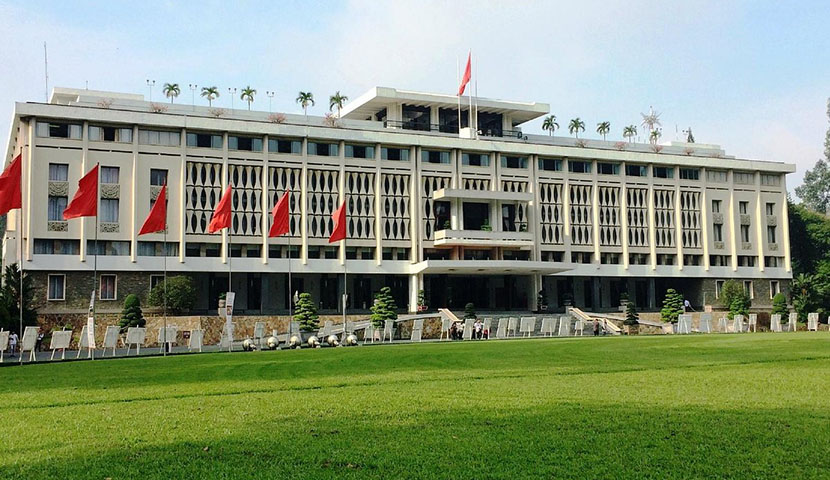
Reunification Palace with 3 floors and unique architecture
Extending beyond the perimeters of the Palace, there are two verdant parks situated both in front and behind the fences. The primary edifice stands majestically with its three floors, accompanied by two mezzanines, a terrace, a ground floor, and a basement. The entirety of the building encompasses a total usable area of 20,000m², artfully divided into 95 rooms. Each room is purposefully designed and adorned with architecture and decorations befitting its specific function.
The Cabinet Room: Used as the venue for meetings and cabinet launch ceremonies, facilitating important decision-making processes.
The State Banquet Hall: This distinguished room hosted notable events and could comfortably accommodate up to 100 guests, providing an elegant setting for grand banquets.
The Presidential Office: Acting as the official workplace of the President, this room served as the nerve center of administrative activities.
The Presidential Family's Residence: Within this private enclave, one can find a serene rock garden, a display showcasing rare gifts, and the personal living quarters of the President and their family, including bedrooms and a dining room.
The Ambassadors Chamber: Adorning its walls is the notable painting "Binh Ngo Dai Cao" (Proclamation of Victory), composed of 40 small pieces depicting the peaceful life of Vietnamese people in the 15th century.
The Basement: Housing the command center and communication department, the basement played a pivotal role in ensuring effective coordination and communication.
The entertaiment rooms: The Library, Cinema, Card-playing Room, Entertainment Lounge, and Casino: These spaces provided avenues for relaxation and leisure for the President and their officers after long hours of work.
Things to see at Reunification Palace
The historical artifacts housed within Reunification Palace bear witness to the heroic history of Vietnam. These significant objects are meticulously preserved, ensuring they remain in impeccable condition for visitors to observe and admire.
With great care and attention, the artifacts serve as a window into the past, allowing visitors to engage with and appreciate the rich heritage of Vietnam.
The historical UH-1 helicopter belonging to President Nguyen Van Thieu. Displayed prominently, it stands as a powerful symbol of the era. Adjacent to this display, one can also find remnants of two bombs that were detonated by pilot Nguyen Thanh Trung during a historic event, offering a poignant reminder of the tumultuous times of the past. Together, these artifacts provide a tangible connection to the significant events and courageous individuals who shaped Vietnam's history.
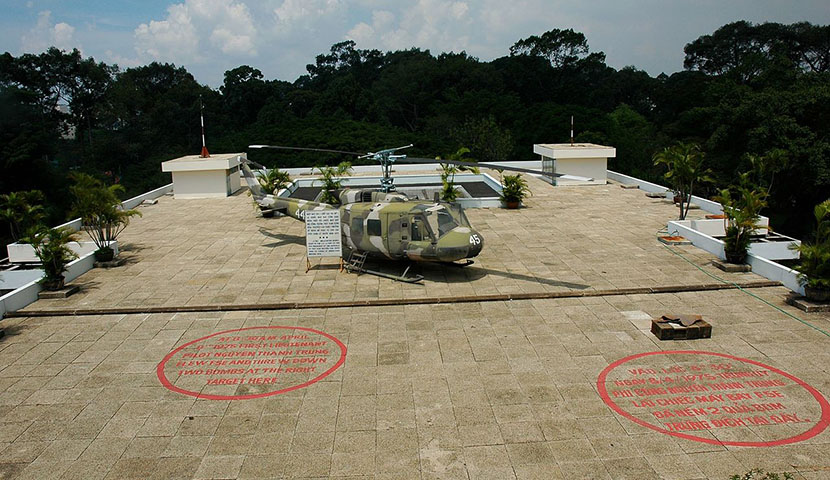
The helicopter on the roof of Reunification Palace
The Mercedes Benz 200 W110, number plate VN-13-78, a German car proudly associated with President Nguyen Van Thieu. This vehicle served as one of the official cars used by President Thieu during his tenure.
The Jeep M152A2, which held great significance as it was utilized by the Revolutionary Forces during a pivotal moment in history. This particular car holds a special place as it once served as the transportation for Mr. Duong Van Minh, the last President of the Vietnam regime.
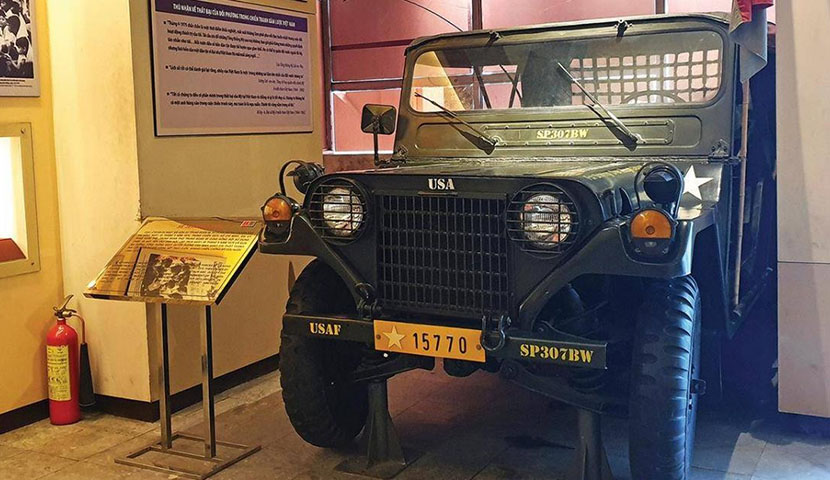
The Jeep in the Reunification Palace
It was in this very vehicle that he was escorted to the Saigon radio station on April 30th, 1975, where he delivered the solemn declaration of surrender.The Jeep M152A2 stands as a powerful testament to the events that marked the end of an era, encapsulating the historical transition and the profound impact it had on Vietnam.
Furthermore, on display at the Reunification Palace, there are also modern vehicles that were utilized during the Vietnam War, including the impressive E 390 and 843 tanks, as well as the iconic F5E fighters.
Related articles
Top 10 things to do in Ho Chi Minh city
Admire Saigon Central Post Office



